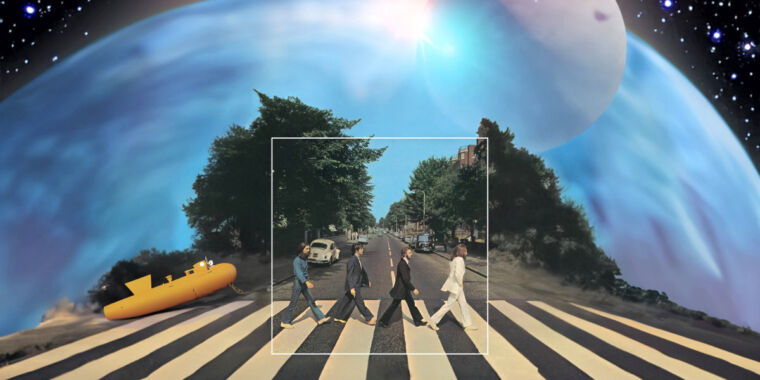AI-Powered Album Cover Artworks Go Viral with Photoshop's Generative Fill
核心概念
Generative Fill in Adobe Photoshop allows users to expand album cover artworks using AI, creating imaginative and sometimes controversial interpretations.
要約
Over the weekend, AI-powered makeovers of famous music album covers went viral on Twitter thanks to Adobe Photoshop's Generative Fill. The tool allows users to expand the size of famous works of art, revealing larger imaginary artworks beyond the borders of the original images. This image-expanding feat, often called "outpainting" in AI circles, is made possible by an image synthesis model called Adobe Firefly trained on millions of works of art from Adobe's stock photo catalog. When given an existing image, Firefly synthesizes plausible continuations based on its knowledge of other artworks. By using text prompts that describe specific scenarios, Generative Fill can create wild and fantastic interpretations beyond what is visible in the original artwork. While some expansions are reasonable based on context, others can be more whimsical and unexpected. To create your own expanded artwork, you need to subscribe to Creative Cloud and download the Adobe Photoshop beta within the Creative Cloud app. By expanding the canvas size and using Generative Fill, users can explore various possibilities for their images. The trend extends beyond album covers to include meme images and famous paintings like the Mona Lisa. Despite generating mixed responses due to technical deficiencies and ethical concerns surrounding AI-generated artwork, Generative Fill continues to entertain social media users with its creative outputs.
AI-expanded album cover artworks go viral thanks to Photoshop’s Generative Fill
統計
An expansion of Michael Jackson's Thriller album rendered the rest of Jackson's body lying on a piano.
An expansion of Katy Perry's Teenage Dream cover art revealed Perry lying on a gigantic fluffy pink cat.
A tweet that expanded several famous meme images garnered almost 10,000 likes on Tuesday.
引用
"Generative Fill has been a visual toy for social media users that keeps on giving."
抽出されたキーインサイト
by Benj Edwards 場所 arstechnica.com 05-31-2023
https://arstechnica.com/information-technology/2023/05/ai-expanded-album-cover-artworks-go-viral-thanks-to-photoshops-generative-fill/
深掘り質問
How does the use of AI in art creation impact traditional artistic practices
The use of AI in art creation has a significant impact on traditional artistic practices. It challenges the notion of authorship and originality, blurring the lines between human creativity and machine-generated output. Traditional artists may feel threatened by AI's ability to quickly generate complex artworks, leading to concerns about job displacement and devaluation of manual artistic skills. On the other hand, some artists embrace AI as a tool for enhancing their creative process, allowing them to explore new techniques and possibilities that were previously unattainable.
What ethical considerations should be taken into account when utilizing AI-generated artwork
When utilizing AI-generated artwork, several ethical considerations must be taken into account. One major concern is the issue of intellectual property rights - who owns the generated artwork? Is it the creator of the AI model or the user who inputs parameters for image generation? Additionally, there are questions surrounding transparency and accountability in AI algorithms - users should be aware of how their data is being used and whether biases are present in the training data that could influence the generated outputs. Moreover, there are moral implications regarding authenticity and value in art - does AI-created artwork hold the same cultural significance as pieces created by human hands?
How can technology like Generative Fill influence future trends in digital content creation
Technology like Generative Fill has the potential to influence future trends in digital content creation by democratizing access to advanced image synthesis tools. As more people experiment with these technologies through platforms like Adobe Photoshop beta, we can expect to see a rise in user-generated content that pushes boundaries creatively. This trend may lead to increased collaboration between humans and machines in artistic endeavors, fostering innovation and diversity in visual storytelling. Furthermore, as AI continues to evolve and improve its capabilities for generating realistic imagery based on text prompts or existing images, we may witness a shift towards more personalized and interactive forms of digital art experiences across various media platforms.
0
